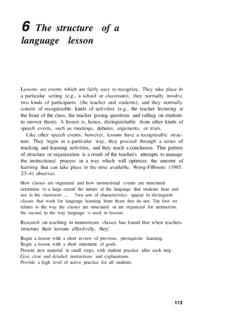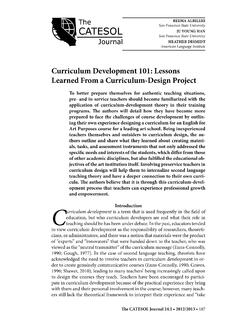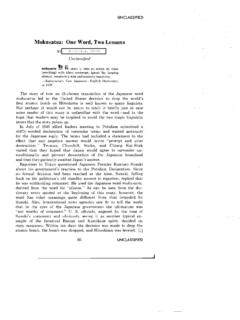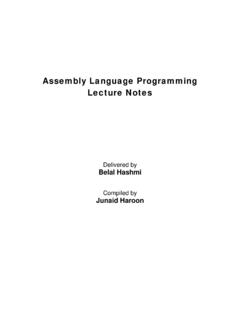Transcription of How Does the First Language Have an Influence on …
1 English Language Teaching; Vol. 10, No. 7; 2017 ISSN 1916-4742 E-ISSN 1916-4750 Published by Canadian Center of Science and Education 123 How Does the First Language Have an Influence on Language Learning? A Case study in an English ESL Classroom Yanilis Romero1,2 & Milton P jaro Manjarres1,2 1 Instituci n Educativa Antonia Santos, Monter a, C rdoba, Colombia 2 Universidad de C rdoba, Monter a, C rdoba, Colombia Correspondence: Milton P jaro Manjarres, Transversal 12 1-11 Barrio Galilea, Monter a, C rdoba, Colombia. Tel: 301-735-7916. E-mail: Received: March 7, 2017 Accepted: June 2, 2017 Online Published: June 6, 2017 doi: URL: Abstract This article presents a case study which aims at analyzing the Influence that the First Language has on the learning of a foreign Language .
2 This research was conducted in an ESL classroom from a Language Center in England and was carried out with a Saudi Arabian student during a two-month period. In order to conduct this research, theoretical support about contrastive analysis (CA) and error analysis (EA) were taken into account. The findings of this case study suggested that CA and EA are effective ways to study and understand how the First Language (L1) of a learner might have an Influence on the learning process in a foreign Language . In this particular case study, it was found that this Saudi Arabian learner had a better performance in receptive skills; there were some evidences of U shape learning in this learner and also it was noticed that his handwriting and the use of punctuation marks although good, they needed some improvement.
3 Keywords: contrastive analysis, error analysis, case study, native Language 1. Introduction Perspectives on Language learning and teaching bring a wide range of important aspects that need to be considered; some of them include culture and native Language . These two features play an important role that might be overseen once Language teachers start instructing. The First Language or L1 (regardless of the country) becomes the First source for a learner to understand how a Language works, specially to young learners who are in the concrete operation phase, as they tend to monitor how they acquire and learn foreign languages. Interestingly, the learning of foreign languages helps students to understand their native one, and they resort to their schemes of L1 to relate to the L2.
4 In this sense, it is relevant to point the importance of students First Language when learning a foreign or second Language . Different researchers, such as Kramsch (1993), Byram and Grundy (2003), and Pulverness (2003) have recently studied the relationship that exists between culture and Language learning. Holmes cited in Byram and Grundy (2003) for instance shows how culture is encoded in the conceptual metaphors speakers of a Language are convinced of. In other words, these encodings are not equal for all languages and for this reason, Language instructors need to be aware of this situation in order to understand how the students learn, depending on the place they come from and the Language they have as mother tongue. This paper presents a case study carried out by two English Teachers with a Saudi Arabian student who belonged to a group of twelve learners learning English as a foreign Language at a Language institute in Southampton, England.
5 Students age range from 15 to 20. The research group asked for a volunteer and explained the purpose of the study having as a result a Saudi Arabian student who volunteered to be part of the study. This study had the purpose of conducting a Contrastive Analysis (CA) about the Language learning process developed by the learner chosen in order to create a Language Learner Profile (LLP) based on the data collected. The purpose of all this is to help the student to do better at his Language learning process. English Language Teaching Vol. 10, No. 7; 2017 124 After identifying different needs, wants and lacks in this Saudi Arabian Learner, the researchers created a set of activities to help the learner cope with skills such as reading and listening.
6 The importance of this piece of research is intended to raise awareness about a major inquiry underlying the teaching process dealing with planning, a phase in which instructors need to consider the heterogeneity of the target audience and the complexity of each students needs. How Does the First Language Have an Influence over the Learning of a New Language ? Language is essential if we want that habits, institutions and beliefs acquire the meaning of what we call culture. In fact, these aspects must have meaning to become culture. According to Kramsch (2013) Language , not seen as a linguistic system, but seen in context is: a coherent symbolic system for making meaning (Kramsch, 2013: 62). In this sense, we cannot separate the study of Language and Language learning from culture and the context that surrounds the learner, especially when we refer to the learning of a foreign Language .
7 Besides culture, the First Language (L1) of a learner might have an Influence over foreign Language learning, either by acting as a source for the learner to understand how the Language works when the First Language and the foreign Language are similar (transfer), or by being a factor of interference if the two languages are very different (negative transfer) (Celaya, M., ). Although some authors such as Krashen (1982) and Dulay and Burt (1974) claim that the process of learning the L2 is similar to the one of learning the L1, some researchers like: Kellerman and Sharwood-Smith (1986) use the term Crosslinguistic Influence to refer to aspects of Language learning such as: transfer, avoidance and borrowing renewing the ideas of transference that appeared in the 50`s and 60 s giving some support to the ideas stated by Lado (1957) who stays that: individuals tend to transfer the forms and meanings (.)
8 Of their native Language and culture to the foreign Language and culture (Lado, 1957 cited in Celaya, :1) The following case study presents an analysis on how the First Language of a Saudi Arabian student learning English had an Influence over his Language learning process. The purpose of this analysis was to show English teachers how having an understanding of the Influence that the L1 has over the learning of a second Language can help to select better teaching materials, prepare more suitable lessons and give more effective instructions to our students Contrastive Analysis One of the key aspects that needs to be considered when talking about the Influence that the L1 has over the learning of a foreign Language is contrastive analysis (CA). According to Johansson (2008) contrastive analysis can be defined as: the systematic comparison between two or more languages, with the aim of describing their similarities and differences.
9 (p. 9) This kind of analysis usually has a pedagogical purpose and it is usually carried out to have better descriptions of the learners performance and select better teaching materials for the learners. When someone is learning a foreign Language , it is common to make mistakes in pronunciation or grammar as a result of the interference of the First Language ; it is here where CA is important because it allows the teacher and the learner to be aware of the difference that exist between two languages in order to learn the correct use of the foreign one. 2. Methodology The Case Study Different authors have defined case studies in different ways depending on their background as researchers. Merriam (1988) for instance states that: Case study can be defined as an intensive, holistic description and analysis of a single entity, phenomenon, or social unit.
10 Case studies are particularistic, descriptive, and heuristic and rely heavily on inductive reasoning in handling multiple data sources (p. 16). One of the key aspects in this definition is the fact that the phenomenon is studied in context. Case studies are centered on description, inference and interpretation, rather than on a formal experiment where the variables are controlled and manipulated. This case study particularly examines and analyses in detail the different strengths, weaknesses and challenges faced by a Saudi Arabian who studies English as a foreign Language at an English Language school in Southampton. This study helps teachers to raise awareness of individual differences among learners. Having a clear understanding about the characteristics of Language learners allows teachers to reflect about the Language needs of foreign students when preparing lessons and selecting teaching materials to effectively teach and guide them.



















